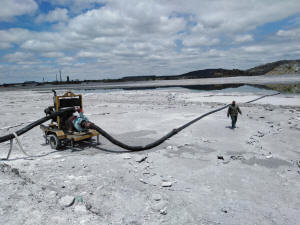Mine waste finds new life as source of rare earths
 Send a link to a friend
Send a link to a friend
 [April 05, 2023]
By Eric Onstad [April 05, 2023]
By Eric Onstad
LONDON (Reuters) - Sweden, South Africa and Australia are at the
forefront of a push to transform piles of mine waste and by-products
into rare earths vital for the green energy revolution, hoping to
substantially cut dependence on Chinese supply.
Prices of the minerals used in products from electric cars to wind
turbines have been strong, and a rush to meet net-zero carbon targets is
expected to further boost demand.
Europe and the U.S. are scrambling to wean themselves off rare earths
from China, which account for 90% of global refined output.
Six advanced projects outside China, including one operated by Swedish
iron ore miner LKAB, are now being developed to extract the materials
from mining debris or by-products.
Australia's RMIT University estimates there are 16.2 million tonnes of
unexploited rare earths in 325 mineral sands deposits worldwide, while
the U.S. Idaho National Laboratory said 100,000 tonnes of rare earths
each year end up in waste from producing phosphoric acid alone.

The six projects, processing material from mineral sands, fertiliser and
iron ore operations, are targeting output of over 10,000 tonnes of key
elements neodymium and praseodymium (NdPr) oxide by 2027, analysis by
Reuters and consultants Adamas Intelligence showed.
That, Adamas says, is equivalent to some 8% of expected demand for the
two rare earths, vital for making permanent magnets to power EV and wind
turbine motors.
Potentially they will cut the expected deficit in the materials by
upwards of 50%, data from Adamas and the Reuters analysis showed.
"These projects are the low-hanging fruit in the supply chain at the
moment," said Ryan Castilloux, managing director at Adamas.
"There's more demand growth coming in the near to medium term than
production, so there's an opportunity for these readily accessible
sources of supply."
QUICKER THAN NEW MINES
Recovering rare earths from waste is much quicker than setting up new
projects from scratch. A new mine that state-owned LKAB is planning to
develop at Europe's largest known deposit of rare earth oxides could
take up to 15 years to launch.
In contrast, its project to isolate rare earths from byproducts from two
existing iron ore mines in northern Sweden is due to kick off in four.

Material from an initial stage of iron ore processing, which is
currently deposited in a tailings dam, will be retained and go through
further treatment stages.
"We want to make sure we extract as much value as possible, and when we
come to the critical minerals, we have those in our ores already," said
David Hognelid, LKAB's chief strategy officer for special products.
[to top of second column]
|

An undated photo shows pumping operation
at Phalaborwa, South Africa, where Rainbow Rare Earths will process
tailings waste left from phosphate mining to extract rare earths.
Rainbow Rare Earths/Handout via REUTERS.

The company will extract phosphorus for fertiliser, fluorine and
gypsum in addition to rare earths.
In South Africa, Rainbow Minerals is also planning to process stacks
of waste from years of phosphate mining.
But the biggest such project is in Australia, where mineral sands
producer Iluka is gearing up to process 1 million tonnes of
stockpiled by-products that have been building up at its Eneabba
site since the 1990s.
It is building a rare earths refinery due to open in 2025 that
together with related infrastructure is expected to cost between A$1
billion ($677.1 million) and A$1.2 billion, helped by a government
loan.
NEW TECHNOLOGY
A key element to making new projects viable is technology developed
to separate the rare earths.
Rainbow Minerals will use a new process developed by U.S. company
K-Technologies based on ion chromatography, which is common in the
pharmaceutical industry and other sectors.
LKAB will be sending its material for separation to Norway's REEtec,
in which it is the biggest shareholder.
Commodity trader Mercuria also bought a stake in REEtec for a new
division that targets metals needed for the energy transition.

"REEtec fits the narrative of building processing capacity for rare
earths in the part of the supply chain where we think there's a
bottleneck," said Guillaume de Dardel, head of energy transition
metals at Mercuria.
"The company's technology has a lower environmental footprint
compared to the legacy solvent extraction process essentially used
for rare earths separation in China."
In the U.S., Phoenix Tailings, funded mainly by venture capital
funds, is using new technology developed by scientists from the
Massachusetts Institute of Technology (MIT).
"There's zero waste, zero emissions and we're also doing it
competitive with Chinese prices. We're not going to rely on
government to fund us," said Chief Executive Nick Myers.
Prices of rare earths have climbed in recent years, making new
projects more viable. Those of NdPr alloy in China, while down from
a peak seen last year, have nearly doubled over the past three
years.
($1 = 1.4769 Australian dollars)
(Reporting by Eric Onstad; Editing by Veronica Brown and Jan Harvey)
[© 2023 Thomson Reuters. All rights
reserved.]This material may not be published,
broadcast, rewritten or redistributed.
Thompson Reuters is solely responsible for this content. |